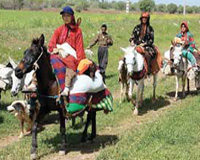At the end of the first half of the twelfth century AH (about 17th century), Afshar tribe in Urumiah, the Donboli tribe in Khoy, Moqaddam in Maragheh, Sheqaqi in the Sarab, and Shahsavan in Ardabil and Qradagh...
At the end of the first half of the twelfth century AH (about 17th century), Afshar tribe in Urumiah, the Donboli tribe in Khoy, Moqaddam in Maragheh, Sheqaqi in the Sarab, and Shahsavan in Ardabil and Qradagh (Ahar), enjoyed population and power.
Although historians of Naderi period rarely speak of Shahsavans, they repeatedly mention the gathered forces of Ahar and Qradagh.
Kazem Soltan was entitled Khan under Nadir Shah as Kazem Khan Qarachedaqi and became Nader Shah’s arsenal head guard.
After the death of Nadir Shah, his nephew, Ibrahim Khan came to throne and called himself Ibrahim Shah. Intending to conquer Tabriz, he fought against AmirArsalan, Beiglar Beigi of Azerbaijan successfully. The Sheqaqi population went under Ibrahim Khan’s rule and Kazem Khan Qarache Daghi became submissive to him.
Ibrahim Khan after killing Amir Arsalan, a brave cousin of Nader Shah, appointed Mehdi Khan Afshar as Beiglar Beigui of Azerbaijan, and he himself left for Khorassan.
Mehdi Khan ill treated his brother, AliMoradKhan in Tabriz. On the other hand, his old and family enemies instigated the public to rise against him. Eventually, they killed Mehdi Khan during the days of rebel and unrest.
At that time, Azad Khan Afghan was in the district of Zur, and Naghi Khan Afshar, Mehdi Khan’s brother had the government of Urumia. Naghi Khan rose to take vengeance, and he asked for the help of Azad Khan Afghan and Shahbaz Donboli, the governor of Khoy and all headed for Tabriz together. They laid siege on Tabriz for forty days.
In this war, Afshar and Afghan forces overcame the Tabrizians. Azad Khan took the power of Tabriz and extended his authority to all parts of Azerbaijan. Then he headed for Erevan, the residents of which with the help of Georgians expelled them from their territory. Azad Khan returned to Tabriz, appointed an official for tax collecting and a governor for the city and left for Urumia.
Following his defeat in Erevan, AzadKhan ill treated the residents of Tabriz and suppressed them. The people of the province revolted against the governor and the tax official appointed by him. Fearing his revenge, they constructed fortifications and asked Kazem Khan Qarachedaghi and Panah Khan Javanshir, and Sheqaqi and Shahsevan tribes for help.
This is was the second time that the Tabrizians asked the Shahsavan and Sheqaqi tribes and nomads for help.
The tribes helped the people of this city and their crowds populate the Azerbaijani capital, Tabriz.
The records of Historians prove that further to Tabriz, the Nomadic Shahsavan People had gone up to Urmia and also participated in the protection of cities and wars.
Meanwhile the Qajar Mohammad Hassan Khan defeated Azad Khan in Guilan headed for Tabriz and Urumia, and through effective helps of FathAli Khan Afshar, Shahbaz Khan Donboli and Kazem Khan Qarachedaghi overcame AzadKhan, he opened Urumia’s fortifications and remained there for six months.
The Qajar commander left his elder son, Mohammad Khan in Tabriz and left for Qazvin with 30000 men to fight against Karim Khan’s forces.
Mohammad Hassan Khan Qajar died in Astarabad, February 1759. At this time, AzadKhan Afghan who was in Baghdad heard of the news, gathered forces to attack Tabriz. The governor of Maraghe, Hajj Ali Mohammad Agha Moqqaddam prevented his advance with the help of Moqqaddam tribe in Bonab. FathAli Khan Afshar and Nojafqoli Khan Donboli arrived from Tabirz. Azad Khan suffered a heavy defeat and fled away.
At this time, Panah Khan Javanshir was the governor of Qarabagh and did not obey the orders of Azerbaijan Beiglar Beigui. Fathali Khan Afshar sent his troops to Qarabagh and brought his son, Ebrahim Khalil Khan to Tabriz and then sent him to Urumia.
Karim Khan Zand’s Arrival at Azerbaijan
After the death of Mohammad Hassan Khan Qajar, and the flight of Afghan Azadkhan from Azarbaijan, Karim Khan found out the scene was devoid of any competing rival.
At the end of 1775, Karim Khan and his forces headed to Azarbaijan. Before entering Tabriz, to deprive FathAli Khan Afshar from the help of the Sheqaqi and the Shahsavan, and weaken his troops, he first went to subdue the tribes and then he attempted to seize and capture Tabriz.
After seizing Tabriz, Karim Khan corresponded with Panah Khan Javanshir, whose son, Ibrahim Khalil Khan was in Urumia prison, and made him his accomplice.
Mixed forces of Zand and Shahsavan tribe, after months of seizure, captured Urumia and its fortifications.
After capturing all Azerbaijani cities, Karim Khan governed Khazem Khan Qarachedaghi, Panah Khan Janvanshir, Sadeq Khan and Nassir Khan, Ali Khan Sheqaqi’s sons and NazarAli Khan Shahsavan, and headed to fight against Zaki Khan in Iraq.
Since this date, Azerbaijan was a pro Zand dependant state until the death of Karim Khan (Safar 1193 AH.) and enjoyed a partial tranquility.
One year subsequent to Karim Khan’s death, a devastating earthquake in Tabriz overshadowed all other events.
The Shahsavan and Sheqaqi tribes were powerful arm and the military lever of Azerbaijan government for sixty or seventy years.
Sometimes they were help to the residents of Tabriz, and sometimes they saw it to their benefit and favor of security of the region to obey another an alien powerful authority. Sometimes they considered themselves fit for governing the region.
The participation of the said tribes in Azerbaijan political and military scenes and their increased contact, developed a wider circle of social relations leading to the promotion of Turkish language in the region.
https://iichs.ir/vdci.razct1awyli2t.html
iichs.ir/vdci.razct1awyli2t.html
